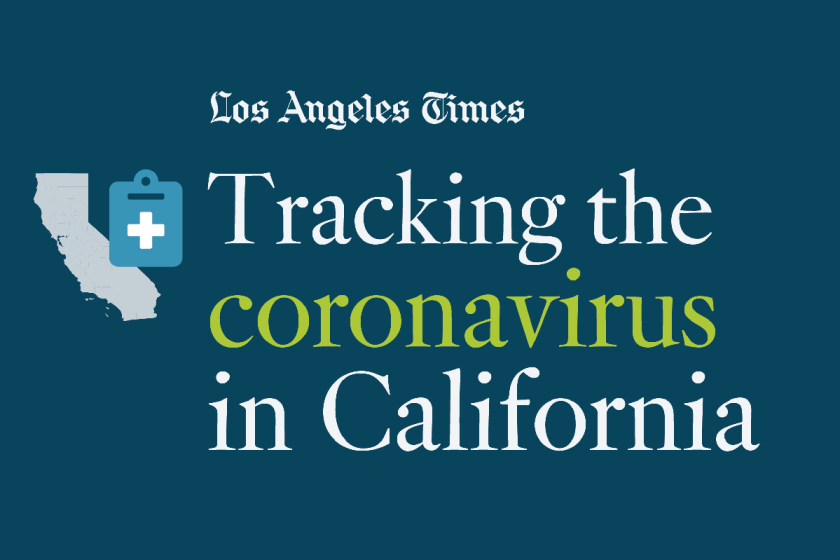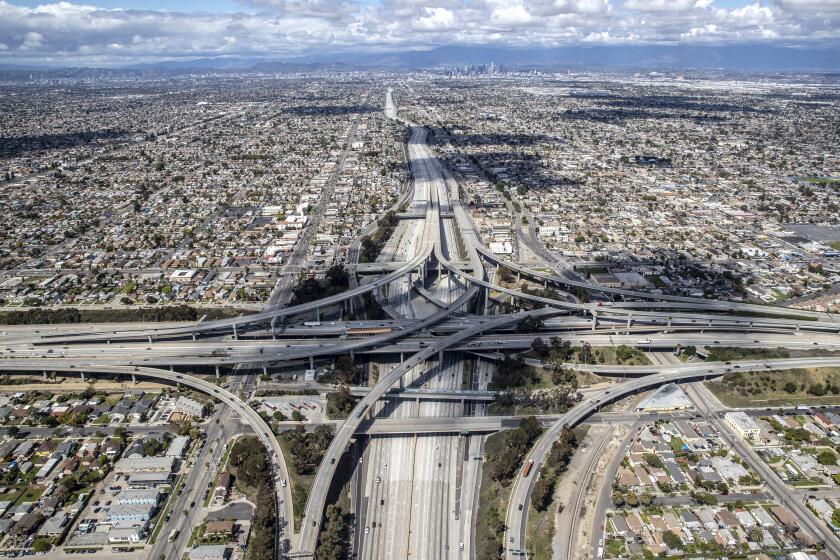During coronavirus spread, L.A. County is still making nonessential trips, data show

Southern Californians have greatly reduced their daily trips since the coronavirus outbreak took hold of the West Coast, and while data show they are doing a good job, it seems their efforts have slipped a bit, according to new figures released Tuesday.
An interactive map unveiled last week by Unacast, a New York-based technology company that aims to put a grade on people’s social distancing efforts, initially gave Los Angeles County and California overall an A for reducing movement during the state’s stay-at-home orders. That score was based on data from millions of anonymous mobile phones comparing the distance that people in each county in the United States traveled before the outbreak started and after it began spreading.
On Tuesday, the company introduced a new metric — a change in visits to venues that state and local officials have deemed nonessential during the pandemic — to help give a more accurate representation about a region’s social distancing efforts.
The new measurement and more strict grading requirements resulted in lower scores for several counties.
The latest maps and charts on the spread of COVID-19 in California.
California — where cases of coronavirus spiked to more than 8,500 Wednesday — received a C overall for reducing movement by at least 40% and reducing visits to nonessential venues by at least 60%. Los Angeles and Ventura counties also saw their grades drop from an A to a C in the latest version of the map.
Residents in Orange County fared slightly better, earning a C for reducing their average distance traveled and a B for limiting their nonessential errands for an overall B-minus grade. San Bernardino and Riverside counties maintained their previous D and C grades, respectively.
Marin, San Francisco, San Mateo and Santa Clara counties maintained their top marks, according to the data.
“We, both at Unacast and as a larger collective community, have learned a lot about COVID-19, and the human behavioral responses to it, in the past week,” Madeline Ngo, the company’s head of insights and analytics, wrote in a post on Unacast’s website Tuesday.
Significantly fewer Californians driving could result in 15,000 fewer collisions per month and 6,000 fewer injury accidents per month, researchers said.
“Two of our Scoreboard updates — the new grading system and the improved methodology that layers in reduction in visits to nonessential venues — combine to paint a more accurate and up-to-date picture of what’s happening in the real world, based on what we know as of this publication.”
The company’s analytics also compared a county’s letter grade to the number of new COVID-19 cases reported in an area to help people draw conclusions about social distancing behavior and the spread of the virus over time.
While the number of coronavirus infections and deaths continues to climb rapidly statewide, public officials and health experts have repeatedly instructed the public to restrict their movements to help stem the virus’ spread. Staying at home was somewhat slow to catch on, with people packing beaches, parks and hiking trails in the early days, a move that eventually forced officials to order closures.
After a person is infected with the coronavirus, it can take two to 14 days for symptoms — most commonly fever, cough and shortness of breath — to appear. Then, in cases where the illness becomes severe, it usually takes an additional eight to 15 days for a patient to require treatment in an intensive care unit.
That means it can take weeks for the effects of stay-at-home orders to become evident.
“Our goal in developing this and our COVID-19 Toolkit is to empower organizations to unearth reliable and valuable information to guide critical decision-making and planning in relation to COVID-19 containment,” Unacast CEO Thomas Walle wrote in a statement. “We are updating the Scorecard and enhancing this COVID-19 Toolkit to provide the most timely and accurate information possible, with the hope of ultimately saving lives.”
More to Read
Start your day right
Sign up for Essential California for news, features and recommendations from the L.A. Times and beyond in your inbox six days a week.
You may occasionally receive promotional content from the Los Angeles Times.









